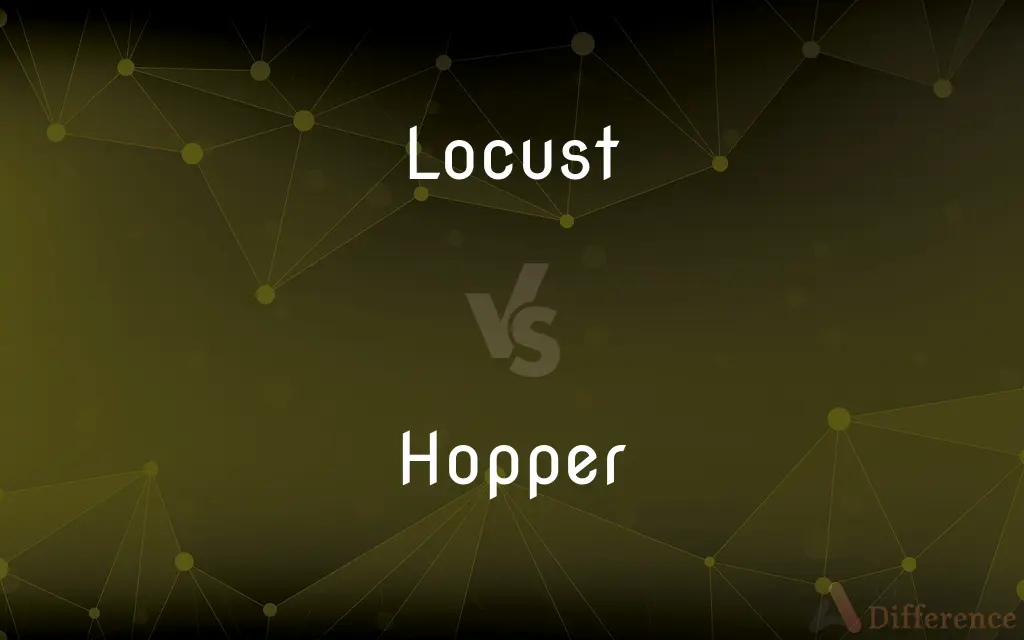Locust vs. Hopper — What's the Difference?
By Fiza Rafique & Urooj Arif — Updated on April 6, 2024
Locusts are a type of grasshopper known for their swarming behavior when environmental conditions trigger their transformation, while "hopper" is a general term that can refer to young grasshoppers or any small jumping insect.

Difference Between Locust and Hopper
Table of Contents
ADVERTISEMENT
Key Differences
Locusts are specific species within the grasshopper family that have the unique ability to change their behavior and form swarms under certain environmental conditions, such as drought followed by rapid vegetation growth. This swarming behavior is a survival mechanism allowing locusts to migrate over vast distances in search of food, often causing significant agricultural damage. On the other hand, the term "hopper" is used colloquially to refer to various small, jumping insects, including young grasshoppers. In the context of grasshoppers, "hopper" specifically denotes their nymph stages, which are wingless and undergo several molts before reaching adulthood.
While locusts are known for their potential to form destructive swarms, not all species of grasshoppers possess this capability. The term "locust" is therefore used to describe grasshoppers of the species that exhibit gregarious and migratory behaviors. In contrast, "hopper" does not imply any swarming behavior and is used more broadly for insects that hop as a primary means of locomotion.
The environmental impact of locusts can be severe, leading to widespread crop destruction and famine in affected regions. These insects are highly adapted to exploit rapidly changing environmental conditions that favor their reproduction and swarm formation. Hoppers, being a developmental stage of grasshoppers and other jumping insects, contribute to the ecosystem in their roles, but do not have the same impact as locust swarms.
Understanding the distinction between locusts and hoppers is essential for agricultural planning and pest control. Effective management strategies for locust swarms require monitoring environmental conditions and locust populations to predict and prevent outbreaks. Meanwhile, managing hoppers involves general pest control measures to protect crops from damage during their growth stages.
The study of locusts and their behavior offers insights into the effects of environmental changes on insect populations and their interactions with ecosystems. In contrast, the term "hopper" broadly encompasses a variety of insects at different stages of life, highlighting the diversity of species that share similar jumping mechanisms for movement.
ADVERTISEMENT
Comparison Chart
Definition
Specific grasshoppers that swarm under certain conditions
General term for young grasshoppers or jumping insects
Behavior
Swarm-forming, migratory
Non-swarming, jumping
Environmental Impact
Can cause significant agricultural damage
Variable, usually minimal compared to locust swarms
Management
Requires monitoring and preventive strategies
General pest control measures
Significance
Studied for their impact on agriculture and ecosystems
Represents a diverse group of jumping insects
Compare with Definitions
Locust
Insect with phase polymorphism.
Locusts exhibit different physical and behavioral traits in their solitary and gregarious phases.
Hopper
Young grasshoppers.
Hoppers lack wings and go through several molts before becoming adults.
Locust
Swarming grasshoppers.
The desert locust is capable of forming massive swarms that devastate crops.
Hopper
Small jumping insects.
The term hopper can also refer to various insects that move by hopping.
Locust
Migratory pests.
Locusts can travel over 100 kilometers in a day in search of food.
Hopper
Undergo incomplete metamorphosis.
As hoppers grow, they gradually develop into their adult form without entering a pupal stage.
Locust
Subject of pest control efforts.
Countries invest in locust control programs to prevent potential outbreaks.
Hopper
Controlled through general measures.
Farmers use pesticides to manage hopper populations and protect crops.
Locust
Cause of agricultural plagues.
Locust swarms have historically caused famines by consuming vast amounts of vegetation.
Hopper
Found in diverse ecosystems.
Hoppers contribute to the ecosystem by serving as prey for numerous predators.
Locust
Locusts (derived from the Vulgar Latin locusta, meaning grasshopper) are a group of certain species of short-horned grasshoppers in the family Acrididae that have a swarming phase. These insects are usually solitary, but under certain circumstances they become more abundant and change their behaviour and habits, becoming gregarious.
Hopper
One that hops.
Locust
Any of various short-horned grasshoppers that sometimes migrate in immense swarms, devouring vegetation and crops.
Hopper
A usually funnel-shaped container in which materials, such as grain or coal, are stored in readiness for dispensation.
Locust
A cicada, especially a periodical cicada.
Hopper
A freight car with a door in the floor through which materials are unloaded.
Locust
Any of several trees of the pea family bearing long pods, especially the black locust, honey locust, and carob.
Hopper
A box in which a bill is placed pending formal introduction before a legislature.
Locust
The wood of any of these trees.
Hopper
(Informal) A place in which something is held in readiness
A studio with many potential blockbusters in the hopper.
Locust
Any of the grasshoppers, often polyphenic and usually swarming, in the family Acrididae that are very destructive to crops and other vegetation, especially the migratory locust (Locusta migratoria).
Hopper
One who or that which hops.
Locust
A fruit or pod of the carob tree.
Hopper
A temporary storage bin, filled from the top and emptied from the bottom, often funnel-shaped.
Locust
Any of various often leguminous trees and shrubs, especially of the genera Robinia and Gleditsia; the locust tree.
Hopper
A funnel-shaped section at the top of a drainpipe used to collect water, from above, from one or more smaller drainpipes.
Locust
A cicada.
Hopper
A bin or device that feeds material into a machine.
Locust
A Mainlander.
Hopper
Various insects
Locust
(intransitive) To come in a swarm.
Hopper
A grasshopper or locust, especially:
Locust
Any one of numerous species of long-winged, migratory, orthopterous insects, of the family Acrididæ, allied to the grasshoppers; esp., (Edipoda migratoria, syn. Pachytylus migratoria, and Acridium perigrinum, of Southern Europe, Asia, and Africa. In the United States the related species with similar habits are usually called grasshoppers. See Grasshopper.
Hopper
The larva of a cheese fly.
Locust
The locust tree. See Locust Tree (definition, note, and phrases).
Hopper
A leafhopper.
Locust
Migratory grasshoppers of warm regions having short antennae
Hopper
Any of various hesperiid butterflies.
Locust
Hardwood from any of various locust trees
Hopper
An artificial fishing lure.
To catch a big fish, use a hopper that jumps across the pond surface.
Locust
Any of various hard-wooded trees of the family Leguminosae
Hopper
(slang) A toilet.
Hopper
(music) An escapement lever in a piano.
Hopper
(obsolete) The game of hopscotch.
Hopper
A window with hinges at the bottom, opened by tilting vertically.
Hopper
A hopper car.
Hopper
(chess) A fairy chess piece which moves only by jumping over another piece.
Hopper
A person or machine that picks hops.
Hopper
A Sri Lankan pancake made from a fermented batter of rice flour, coconut milk, and palm toddy or yeast.
Hopper
One who, or that which, hops.
Hopper
A chute, box, or receptacle, usually funnel-shaped with an opening at the lower part, for delivering or feeding any material, as to a machine; as, the wooden box with its trough through which grain passes into a mill by joining or shaking, or a funnel through which fuel passes into a furnace, or coal, etc., into a car.
Hopper
See Grasshopper, 2.
Hopper
A game. See Hopscotch.
Hopper
See Grasshopper, and Frog hopper, Grape hopper, Leaf hopper, Tree hopper, under Frog, Grape, Leaf, and Tree.
Hopper
A vessel for carrying waste, garbage, etc., out to sea, so constructed as to discharge its load by a mechanical contrivance; - called also dumping scow.
Hopper
Funnel-shaped receptacle; contents pass by gravity into a receptacle below
Hopper
Someone who hops;
At hopscotch, the best hoppers are the children
Hopper
A machine used for picking hops
Hopper
Terrestrial plant-eating insect with hind legs adapted for leaping
Hopper
(baseball) a hit that travels along the ground
Common Curiosities
Are all grasshoppers capable of swarming like locusts?
No, only specific species of grasshoppers known as locusts have the ability to form swarms.
Can locusts cause damage individually, or only as swarms?
While individual locusts can consume vegetation, the significant agricultural damage is caused when they form swarms.
What is the difference between a locust and a hopper?
A locust is a type of grasshopper known for swarming, while a hopper refers to young grasshoppers or any small jumping insect.
What strategies are used to control locust swarms?
Strategies include monitoring environmental conditions, locust populations, and applying targeted pesticide treatments to prevent swarms.
How do locusts travel long distances?
Locusts have strong wings and can be carried by winds, allowing them to travel over 100 kilometers in a single day.
Do hoppers pose the same threat to agriculture as locusts?
Hoppers, especially in their nymph stages, can damage crops, but they do not pose the same large-scale threat as locust swarms.
What impact do locust swarms have on the environment?
Beyond crop damage, locust swarms can lead to ecological imbalances by rapidly consuming vegetation needed by other species.
What triggers locusts to form swarms?
Environmental conditions such as drought followed by rapid vegetation growth trigger locusts to change behavior and form swarms.
How do farmers manage hopper populations?
Farmers use general pest control measures, such as pesticides, to manage hopper populations and protect crops.
Why are locust swarms considered a major agricultural threat?
Locust swarms can consume vast amounts of vegetation, leading to crop destruction and famine in affected areas.
How can locust swarms be predicted?
By monitoring specific environmental triggers and locust breeding patterns, scientists can predict potential swarms.
How are locusts and hoppers different in their development?
Locusts undergo phase polymorphism with solitary and gregarious phases, while hoppers simply refer to the immature stages of grasshoppers and other insects, gradually developing into their adult forms.
Are hoppers only found in agricultural settings?
No, hoppers are found in various ecosystems, contributing to the food chain and biodiversity.
What role do hoppers play in the ecosystem?
Hoppers serve as a food source for many predators, contributing to the ecological balance.
Can locusts be eaten by humans or animals?
Yes, in some cultures, locusts are consumed as a source of protein, and they can also serve as feed for livestock.
Share Your Discovery

Previous Comparison
Msg vs. Mag
Next Comparison
Sight vs. AttractionAuthor Spotlight
Written by
Fiza RafiqueFiza Rafique is a skilled content writer at AskDifference.com, where she meticulously refines and enhances written pieces. Drawing from her vast editorial expertise, Fiza ensures clarity, accuracy, and precision in every article. Passionate about language, she continually seeks to elevate the quality of content for readers worldwide.
Co-written by
Urooj ArifUrooj is a skilled content writer at Ask Difference, known for her exceptional ability to simplify complex topics into engaging and informative content. With a passion for research and a flair for clear, concise writing, she consistently delivers articles that resonate with our diverse audience.














































